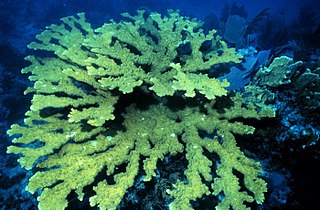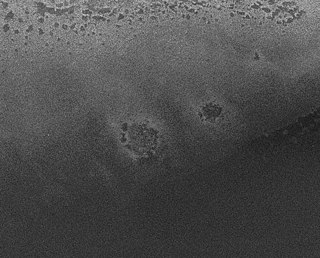
The Florida Keys National Marine Sanctuary is a U.S. National Marine Sanctuary in the Florida Keys. It includes the Florida Reef, the only barrier coral reef in North America and the third-largest coral barrier reef in the world. It also has extensive mangrove forest and seagrass fields. The Florida Keys National Marine Sanctuary, designated in 1990, is the ninth national marine sanctuary to be established in a system that comprises 13 sanctuaries and two marine national monuments. The Florida Keys National Marine Sanctuary protects approximately 2,900 square nautical miles of coastal and ocean waters from the estuarine waters of south Florida along the Florida Keys archipelago, encompassing more than 1,700 islands, out to the Dry Tortugas National Park, reaching into the Atlantic Ocean, Florida Bay and the Gulf of Mexico.

The staghorn coral is a branching, stony coral with cylindrical branches ranging from a few centimetres to over two metres in length and height. It occurs in back reef and fore reef environments from 0 to 30 m depth. Wave forces dictate the upper threshold, while suspended sediments and the availability of light regulate the lower boundary. Until the mid-1980s, the intermediate depths of 5–25 meters in the fore reef zones were once primarily occupied by vast areas of staghorn coral, consisting largely of single-species stands. This coral exhibits the fastest growth of all known western Atlantic fringe corals, with branches increasing in length by 10–20 cm (3.9–7.9 in) per year. This has been one of the three most important Caribbean corals in terms of its contribution to reef growth and fishery habitat.

Elkhorn coral is an important reef-building coral in the Caribbean. The species has a complex structure with many branches which resemble that of elk antlers; hence, the common name. The branching structure creates habitat and shelter for many other reef species. Elkhorn coral is known to grow quickly with an average growth rate of 5 to 10 cm per year. They can reproduce both sexually and asexually, though asexual reproduction is much more common and occurs through a process called fragmentation.

Molasses Reef is a coral reef located within the Florida Keys National Marine Sanctuary. It lies to the southeast of Key Largo, within the Key Largo Existing Management Area, which is immediately to the east of John Pennekamp Coral Reef State Park. This reef is within a Sanctuary Preservation Area (SPA).
Carysfort is a coral reef located within the Florida Keys National Marine Sanctuary. It lies to the east of Key Largo, within the Key Largo Existing Management Area, which is immediately to the east of John Pennekamp Coral Reef State Park. This reef is within a Sanctuary Preservation Area (SPA). The reef is northeast of The Elbow. The Carysfort Reef Light is near the center of the SPA.

The Elbow is a coral reef located within the Florida Keys National Marine Sanctuary. It lies to the east of Key Largo, within the Key Largo Existing Management Area, which is immediately to the east of John Pennekamp Coral Reef State Park. This reef is within a Sanctuary Preservation Area (SPA). The Elbow is southwest of Carysfort and east of Dry Rocks reefs.

Dry Rocks is a coral reef located within the Florida Keys National Marine Sanctuary. It lies east of Key Largo, within the Key Largo Existing Management Area, which is immediately east of John Pennekamp Coral Reef State Park. The reef lies within a Sanctuary Preservation Area (SPA). It is close to Grecian Rocks and The Elbow.
Grecian Rocks is a coral reef located within the Florida Keys National Marine Sanctuary. It lies to the east of Key Largo, within the Key Largo Existing Management Area, which is immediately to the east of John Pennekamp Coral Reef State Park. This reef is within a Sanctuary Preservation Area (SPA).
French Reef is a coral reef located within the Florida Keys National Marine Sanctuary. It lies 11 km southeast of Key Largo, within the Key Largo Existing Management Area, which is immediately to the east of John Pennekamp Coral Reef State Park. French Reef is northeast of Molasses Reef. Part of the reef lies within a Sanctuary Preservation Area (SPA), which is 37 ha in area. A number of caves and arches in a spur and groove formation are included in the SPA.
Conch Reef is a coral reef located within the Florida Keys National Marine Sanctuary. It lies to the southeast of Plantation Key. This reef is within a Sanctuary Preservation Area (SPA). Adjacent to the SPA is a "Research Only" zone and the Aquarius underwater laboratory is at the center of the zone. Outside of these zones is Conch Wall, a deep wall reef.
Davis Reef is a coral reef located within the Florida Keys National Marine Sanctuary. It lies to the southeast of Plantation Key. This reef lies within a Sanctuary Preservation Area (SPA).
Hen and Chickens is a shallow coral reef located within the Florida Keys National Marine Sanctuary. For a while in the 20th century it was marked by the Hen and Chickens Shoal Light. It lies to the southeast of Plantation Key. This reef lies within a Sanctuary Preservation Area (SPA).
Alligator Reef is a coral reef located within the Florida Keys National Marine Sanctuary. It lies to the southeast of Upper Matecumbe Key. This reef lies within a Sanctuary Preservation Area (SPA).

Tennessee Reef is a coral reef located within the Florida Keys National Marine Sanctuary. It lies to the southeast of Long Key. It consists of drowned (deep) spur-and-groove reef. Much of the reef is within a designated "Research Only" zone.
Coffins Patch is a shallow coral reef located within the Florida Keys National Marine Sanctuary. It lies to the southeast of Bamboo Key. This reef lies within a Sanctuary Preservation Area (SPA).

Newfound Harbor Key is a shallow coral reef located within the Florida Keys National Marine Sanctuary. It lies to the south of Big Pine Key, and north of Looe Key. This reef is within a Sanctuary Preservation Area (SPA).

Rock Key is a coral reef located within the Florida Keys National Marine Sanctuary. It lies to the southwest of Key West, within the Key West National Wildlife Refuge. This reef is within a Sanctuary Preservation Area (SPA).

Sand Key is a coral reef located within the Florida Keys National Marine Sanctuary. It lies to the southwest of Key West within the Key West National Wildlife Refuge. This reef is within a Sanctuary Preservation Area (SPA).
Snapper Ledge is a small coral reef located within the Florida Keys National Marine Sanctuary. It lies to the southeast of Key Largo, to the south the Key Largo Existing Management Area and John Pennekamp Coral Reef State Park. Unlike many reefs within the Sanctuary, this reef is not within a Sanctuary Preservation Area (SPA). It is near Pickles Reef. Since 2009, the Coral Restoration Foundation has used Snapper Ledge as a nursery site to grow Elkhorn coral.
The St. Croix East End Marine Park (STXEEMP) was established to "protect territorially significant marine resources, and promote sustainability of marine ecosystems, including coral reefs, sea grass beds, wildlife habitats and other resources, and to conserve and preserve significant natural areas for the use and benefit of future generations." It is the U.S. Virgin Islands’ first territorially designated and managed marine protected area (MPA).















